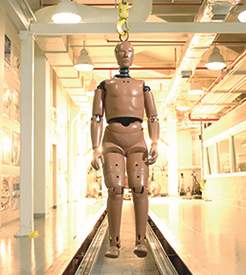Title
Safe Transport of Spica Casted Infants: Reducing the Risk of Traumatic Injury in Side Impact Collisions
Document Type
Article
Publication Date
9-4-2021
Publication Title
The American Journal of Surgery
Abstract
Background
There is limited data on transporting small children in hip spica casts used to treat pediatric femur fractures. Specific challenges include the fixed position of the body in the casted position and the increased size of the child due to cast thickness. Additionally, children less than 2 years old are recommended to be rear facing during transportation. This traveling position requires seats that are specifically designed to accommodate the small size of the child as well as accommodate the rear facing position. While seats able to accommodate casted children are available, it is unclear if they provide adequate protection in side impact collisions for rear facing spica casted infants. Therefore, the aim of this study was to evaluate traumatic injury metrics in a side impact collision model where a spica casted infant crash dummy was restrained in currently available car seats.Methods
Two seats designed for spica casted children (R82 Quokka, Merritt Wallenberg) and two traditional car seats (Britax Emblem, Graco Sequel) able to accommodate a casted one-year-old crash test dummy were identified. Side impact collision testing was performed with the dummy positioned in the rear facing position and injury metrics recorded.Results
Testing identified contact between the dummy's head and the door panel for a specialty spica car seat without protective side-wings for the head. All other seats contained side wings and prevented door-head contact.Conclusions
Casted children should be transported in a seat able to accommodate the cast and safely restrain them. Our results demonstrate the importance of side wing protection in any seat used to transport these children as side bolsters may help decrease the potential for head contact with the door and lower the risk of severe head injury.Volume
223
Issue
1
First Page
164
Last Page
169
DOI
https://doi.org/10.1016/j.amjsurg.2021.08.039
ISSN
Print: 0002-9610
Rights
© 2021 Published by Elsevier Inc.
Recommended Citation
Collins, Angela; Adams, Nate; Ostrander, James; Atkinson, Patrick; and Atkinson, Theresa, "Safe Transport of Spica Casted Infants: Reducing the Risk of Traumatic Injury in Side Impact Collisions" (2021). Crash Safety Center Publications. 44.
https://digitalcommons.kettering.edu/crash_pubs/44


